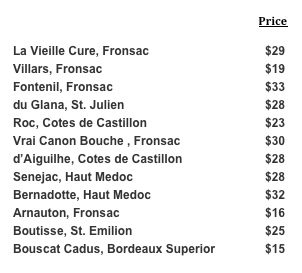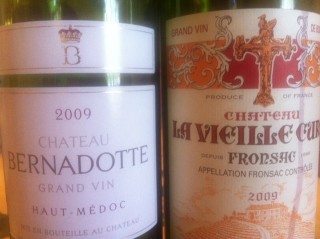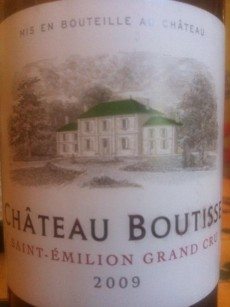 The wines hidden inside brown paper bags came from Fronsac, Castillon, and the Haut Medoc. There were two token wines, one from St. Julien and the other St. Emilion. The most expensive bottle of 2009 Bordeaux in the lineup was $33 retail, insuring that the evening’s foundation would be poured and hardened sans pedigree. Besides a good look at the vintage’s character, our Boston blind tasting group was poised to hunt value outside the boldly priced classified growths of the undisputed stellar 2009 Bordeaux release.
The wines hidden inside brown paper bags came from Fronsac, Castillon, and the Haut Medoc. There were two token wines, one from St. Julien and the other St. Emilion. The most expensive bottle of 2009 Bordeaux in the lineup was $33 retail, insuring that the evening’s foundation would be poured and hardened sans pedigree. Besides a good look at the vintage’s character, our Boston blind tasting group was poised to hunt value outside the boldly priced classified growths of the undisputed stellar 2009 Bordeaux release.
Great Bordeaux vintages used to be easy to deal with. Buy the top wines in the best years and lay them away for 10, 20, 50, or 75 years. That was a no-brainer strategy when first growths like Latour, Haut Brion, and Margaux sold for $50-$75 and second growths like Pichon Lalande cost less than $400 a dozen. Today, the average release price on wine-searcher for one bottle of 2009 Chateau Margaux is $1,352. Without adjusting purchase patterns, it would be easy to spend $20,000 in every strong vintage on a half dozen cases for the cellar. Since Bordeaux lives very near the top of the wine food chain in my world, creative acquisition strategies would need to replace shopping lists laden with venerable chateaus. In the fall of 2011, Neal Martin of the Wine Advocate wrote this after tasting through more than 100 2009 Cru Bourgeois:
…for all those disenfranchised Bordeaux-lovers who vowed never to buy Claret again after facing escalating prices. I would urge you to consider some of the rich pickings to be found. These are wines that are a fraction of the price of the top names, these are wines that are physically available and these are wines that at best, give the Grand Cru Classé a damn good run for their money….They combine Bordeaux classicism with the ripe fruit that the 2009 vintage bestowed, the textures are often silky smooth and many display wonderful delineation, precision and purity on the finish.
 Thinking about the glory in Bordeaux, it is impossible to escape the discussion of aging and balance; tannin for structure and its supporting role in aging, fruit for its terroir driven purity and charm, and acidity for the liveliness it gives to the fruit. While some great vintages showcase riper fruit like 1990 and others more backward tannic cloaked wines like 1986, the best of the best vintages are about impeccable balance. I’ve concluded it’s that balance, along with the natural gifts of the Bordeaux growing region, that allows these wines to age into the gracefully elegant old claret that makes aging Bordeaux a worthwhile endeavor. We discovered that very signature balance associated with the greatest Bordeaux years in the twelve bottles of humble 2009s we examined next to each other, blind. If one consistent difference between the greatest chateau and these just might be length of time to maturity, the best of the wines we tasted should deliver magical silky drinking in 10-20 years.
Thinking about the glory in Bordeaux, it is impossible to escape the discussion of aging and balance; tannin for structure and its supporting role in aging, fruit for its terroir driven purity and charm, and acidity for the liveliness it gives to the fruit. While some great vintages showcase riper fruit like 1990 and others more backward tannic cloaked wines like 1986, the best of the best vintages are about impeccable balance. I’ve concluded it’s that balance, along with the natural gifts of the Bordeaux growing region, that allows these wines to age into the gracefully elegant old claret that makes aging Bordeaux a worthwhile endeavor. We discovered that very signature balance associated with the greatest Bordeaux years in the twelve bottles of humble 2009s we examined next to each other, blind. If one consistent difference between the greatest chateau and these just might be length of time to maturity, the best of the wines we tasted should deliver magical silky drinking in 10-20 years.
Scanning my notes I noticed repetitive indications of good acidity, manageable tannins, and sweet berry fruit. A friend with one of the finest Bordeaux knowledge banks and tasting acumen despite having grown up in the Languedoc, Jacques, compared these wines to the best of the 2008 vintage; “balanced and nicely rounded….food wines”. Jacques suggested that the wines would be at their peak in 12-15 years. The one thing the entire group of 17 seemed to agree on is that the best of the wines we tasted were severe values, and a viable path to filling a piece of the cellar as homage to the ’09 vintage. For my part, I will be buying the top five wines by the case and laying them away for at least ten years. Here are some of the highlight wines of the evening:
$31 **** 2009 La Vieille Cure, Fronsac
The evening’s second place wine, and my own favorite wine of the tasting. The color was the blackest and most opaque of all, with exotic aromas of soy sauce and Szechuan peppercorns, big, ripe, and a lengthy memorable finish.
 $24 **** 2009 Chateau Boutisse, St. Emilion
$24 **** 2009 Chateau Boutisse, St. EmilionMy second favorite wine, but not voted on nor favored by the rest of the group. Light in color with mocha and tobacco leaf on the nose, the wine combined rich ripe kirsch fruit flavor with a solid finish. It boasts class and elegance now.
$24 ***1/2 2009 Chateau Bernadotte, Haut Medoc
This was the group’s favorite wine of the night. I liked the wine, a beautiful perfumed nose, char, rasberry fruit, and excellent acid and tannin levels.
$29 *** Vrai Canon Bouche, Fronsac
While the wine won third place on point votes, it was a highly contested wine with half the group heralding it and the other half stingy in their praise. I liked the wine for its strength in the mid palate, its richness, and massive mouthfeel.
The only two wines in the group that did not figure into anyone’s recommendations were the Roc and Bouscat Cadus.